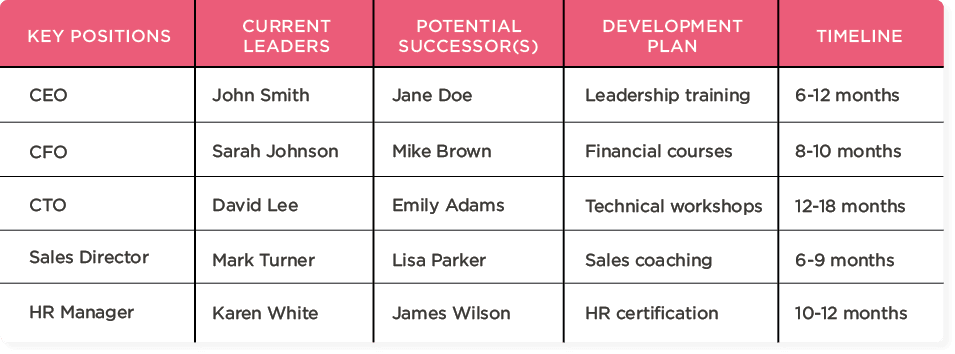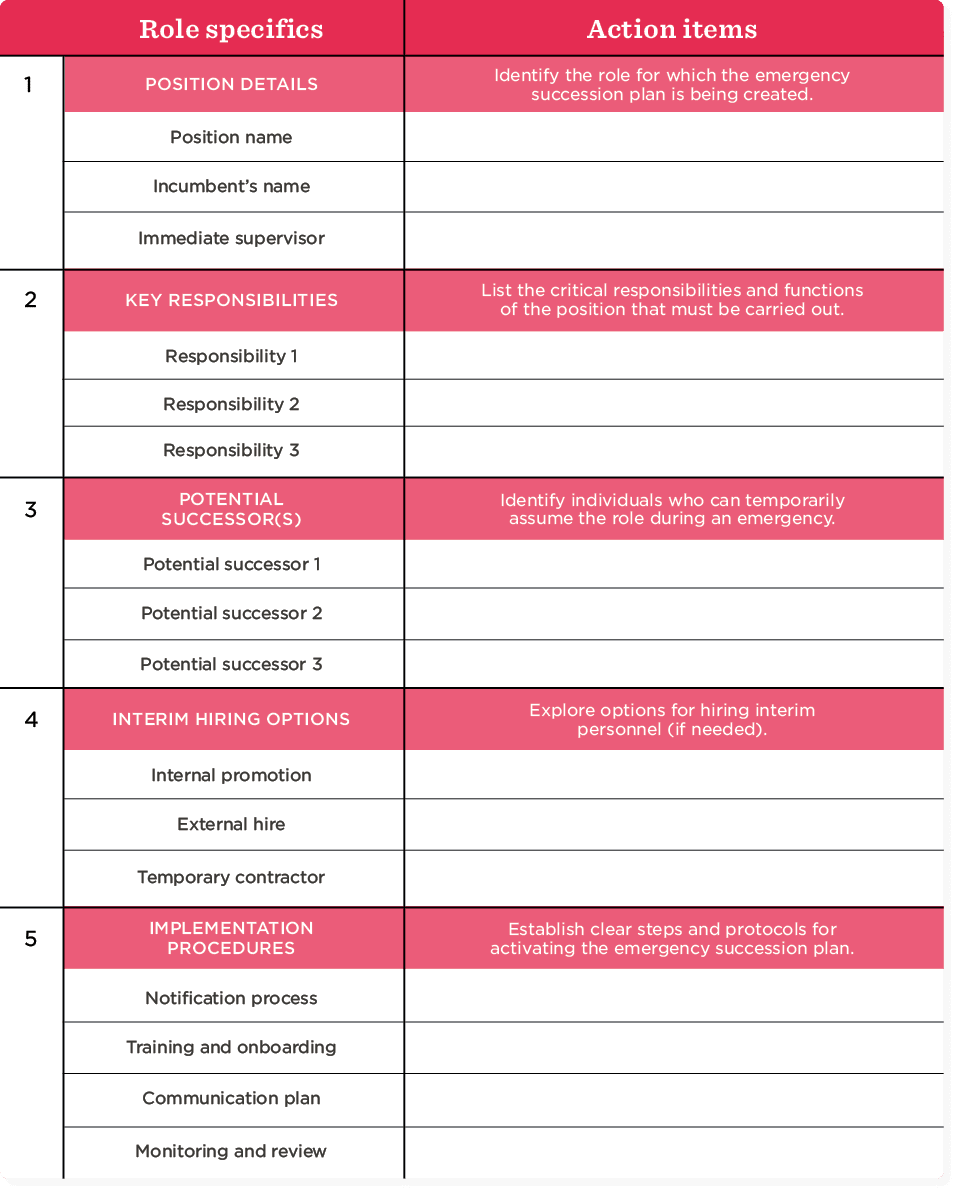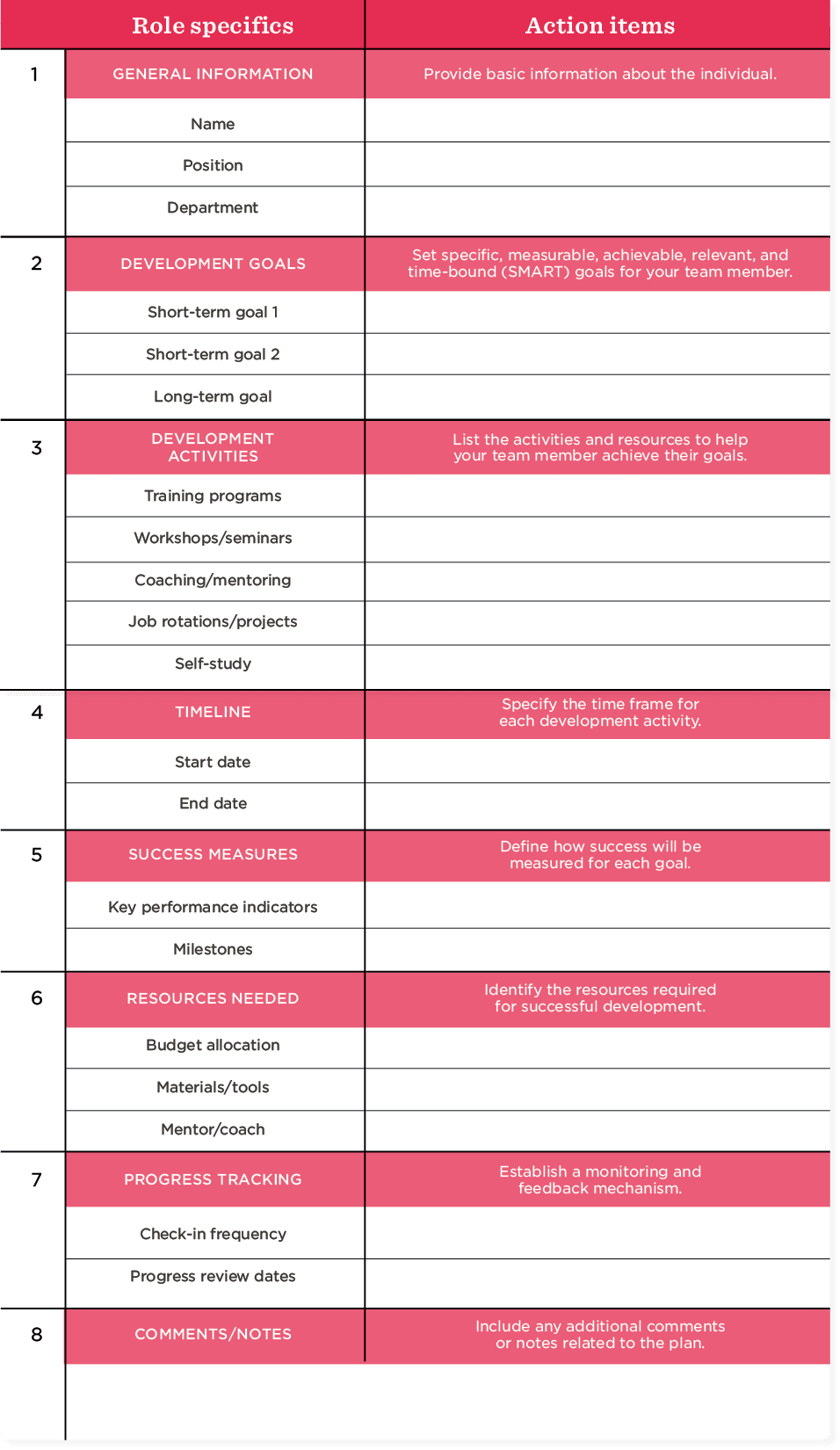In the modern world of business, one thing is certain: Change is inevitable. And as organizations evolve, so do their leadership needs. To be on top of these changes, it’s vital to have a plan.
This is where succession planning steps into the spotlight. It’s not merely a human resources protocol—it’s a strategic imperative.
Using a succession planning template, you can create a comprehensive and proactive succession plan to avoid unplanned downtime and boost morale. When team members see there’s a smooth plan in place for every big change, they feel more certain about the future of their workplace.
This guide delves into the pivotal role of succession planning in HR with key examples you’re likely to come across. Plus, you can download all of our free succession planning templates by clicking the links below.
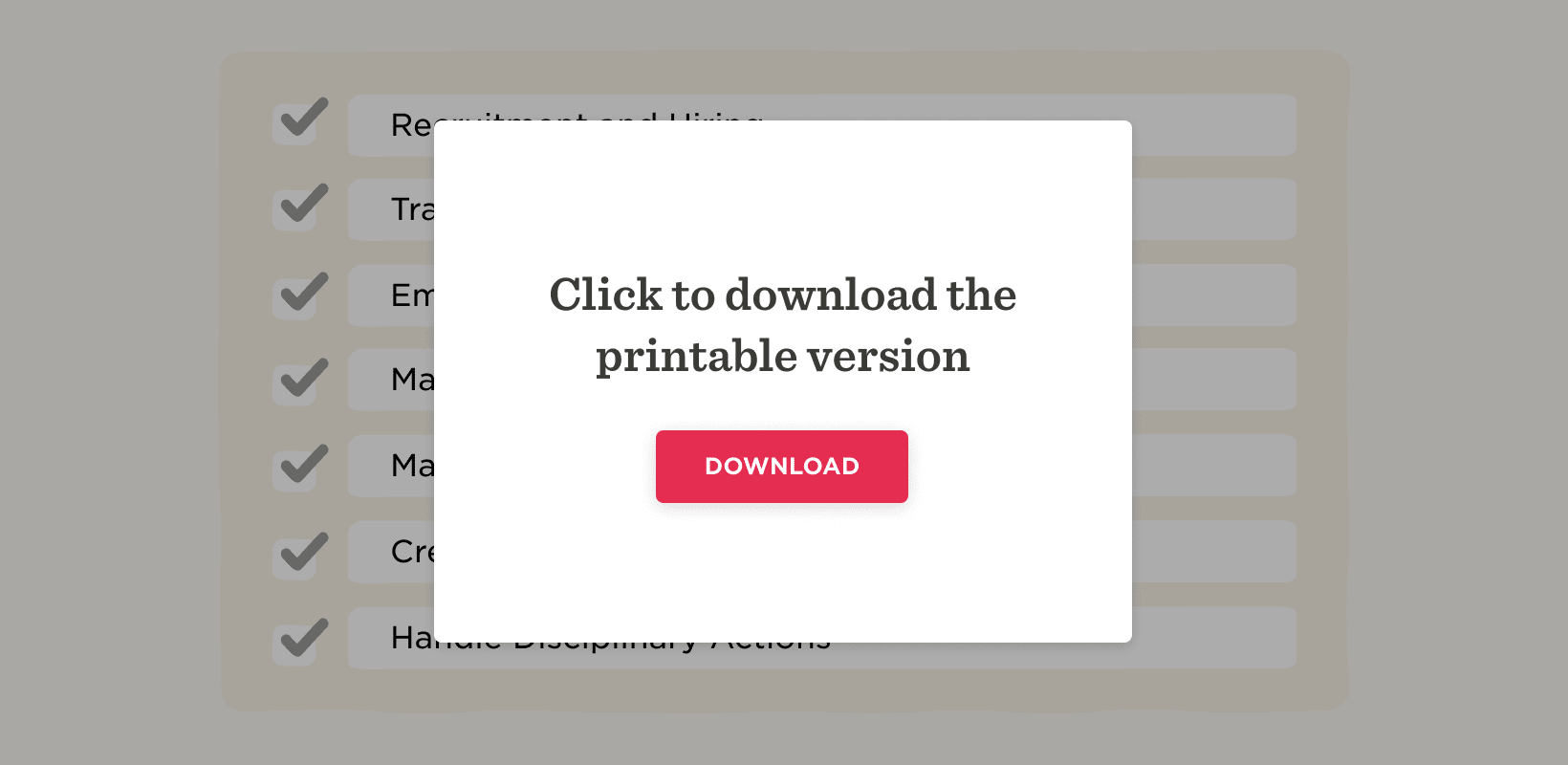
<<Download and print these templates to build an effective succession plan.>>
What is succession planning?
Succession planning involves developing internal talent to fill future vacancies within an organization. This long-term strategy prepares team members for future roles so that if senior-level team members leave an organization, you can seamlessly transition responsibilities without disrupting business operations.
Succession planning also helps team members understand their career path and trajectory, which can encourage skill development and training participation.
What is a succession planning template?
A succession planning template offers a structured and predictable system to help an organization prepare for key personnel changes within the company.
You can use a succession planning template as a roadmap to outline the next steps and strategies you need to identify, nurture, and promote internal talent to fill critical positions in your organization.
Templates can include sections for evaluating current talent, identifying potential successors, creating development plans, establishing timelines, and addressing contingency scenarios.
Providing a clear and organized framework ultimately streamlines the process, ensuring that your organization can:
- Proactively respond to leadership changes
- Pre-empt risks associated with talent gaps
- Maintain business continuity and strategic direction
A succession planning framework empowers businesses to secure their futures by nurturing their talent today.
Why use a succession planning template?
During succession planning, it’s important to take care of the basics. This means having a firm grasp of your succession planning metrics—from bench strength to retention.
Succession planning templates also:
- Bring structure and organization to what can otherwise be a complex and daunting process. A clear, step-by-step framework guides HR professionals and leadership teams through each stage of succession planning, ensuring that no critical elements are overlooked.
- Promote consistency and transparency within an organization. By following a standardized approach, all stakeholders have a common understanding of the process, criteria, and expectations, reducing the risk of bias and favoritism.
- Save time and resources. A template eliminates the need to “reinvent the wheel” for each succession planning cycle, making the process more efficient and cost-effective. With a template, organizations can quickly adapt and update their succession plans to align with changing business priorities and talent development needs.
- Help organizations future-proof themselves by identifying and developing their internal talent pool. It ensures that even during unexpected leadership changes, there are qualified individuals ready to step into key roles, maintaining business continuity and stability.
<<Download and print these templates to build an effective succession plan.>>
How to create a succession planning template
Start with the end in mind. Succession planning templates will differ based on your organization’s needs.
For instance, a skills gap analysis template will be completely different from a basic succession planning template since they’re used for different purposes—but each template will have the same basic components.
Here’s what to do when creating a succession planning template for your organization:
1. Identify key positions
Begin by identifying the key roles within your organization requiring succession planning. These are typically leadership roles and other critical positions. Think about which roles your organization truly can’t function without, like C-suite executives, operations leaders, HR managers, and IT experts.
2. Gather information
Collect data on the current incumbents of these positions, including their skills, strengths, weaknesses, and expected retirement dates or potential departure scenarios. Conduct open conversations with the person leaving as well as the team members working with them directly, and dig into research to form a robust view of each position.
3. Determine successor criteria
Define the criteria for potential successors based on interviews with team members in the current roles and on your research. Consider factors like skills, experience, leadership qualities, and alignment with organizational values.
4. Outline development plans and a timeline
Outline specific development plans for each potential successor and establish a clear development timeline. This may include training programs, mentorship opportunities, and cross-functional experiences.
Establish a timeline for the succession planning process, including key milestones, reviews, and deadlines for various stages.
5. Establish a communication strategy
Plan how to communicate the succession plan to relevant stakeholders, including team members, leaders, and potential successors. Succession planning gives you the space to have ongoing conversations and take a mindful approach to these changes.
Transparency paves the way for smoother, more supportive development and an easier transition.
6. Monitor and review
Set up a system to monitor and evaluate the effectiveness of your succession planning strategy. Define key performance indicators (KPIs) and regular performance review cycles.
For example, you could evaluate the accuracy of your timelines, the effectiveness of your training materials, and the feedback from team member surveys throughout the process. For team members in the new role, set up ongoing check-ins to gather feedback about the development and planning process, and monitor their skills and performance to fully understand any gaps in preparation.
7. Carry out contingency planning
Careful and targeted succession planning works well when you can anticipate a departure, such as a retirement. However, sometimes crucial team members move on without much notice—and you still need to fill their role.
Develop contingency plans for unexpected leadership changes, such as sudden departures or emergencies. While they might not contain as much thorough detail as your other succession plans, you’ll still have next steps in place.
8. Assess legal and ethical considerations
Ensure your plan complies with legal and ethical standards, including diversity, equity, and inclusion (DE&I) considerations. Consult with your compliance team and DE&I leaders every step of the process.
9. Document the plan
Create a succession planning template that encompasses these elements to provide a structured framework for the entire process. Include clear instructions so teams across your organization can internalize the template and use it effectively.
Remember, an effective succession planning template evolves with your organization’s needs and the changing talent landscape.
Regularly check and update it to keep you one step ahead of emerging challenges and ready to embrace new opportunities.
<<Download and print these succession templates to build an effective plan.>>
Free succession planning templates
Now you have the basic components of a succession planning template. You know why having a succession planning template is a good idea for your HR processes. But what about seeing how a succession planning template works in action?
We’ve included five templates below—all used for different purposes—that can prove useful to your organization, no matter which industry you’re in.
Basic succession planning template
This workforce planning template takes a straightforward approach to succession planning. You can adapt it for whatever your company needs most.
For instance, you may want an overall executive succession planning template, covering the most executive positions in your business. Or you may want to tailor it for just one position—for example, for a CEO succession planning template.
This template provides structure while giving you plenty of room for adaptation.
Emergency succession planning template
As anyone in HR already knows, life happens. This emergency succession planning template helps your organization achieve seamless personnel transitions, especially in the event of an unforeseen leadership change.
Use this template as your foundation to create a strategic blueprint for managing temporary or unanticipated absences of key personnel, such as executive directors or CEOs.
First, identify the main duties that must be carried out, explore contingency measures for interim or alternative hires, and establish clear protocols for the seamless execution of your emergency succession plan.
Customize this flexible template to suit your organization’s specific needs.
Skills gap analysis template
Take a look at your team member’s skills to determine who would be best to take on an open role.
A skills gap analysis template, within the context of succession planning, helps you assess both the current competencies and future skill requirements needed to transition into key roles within your organization.
If you spot gaps between an individual’s existing skills and the skills they need to succeed in a higher-level position, you can pinpoint what targeted training, development, and mentorship programs they might need to bridge those gaps.
This template helps you to proactively cultivate a pipeline of qualified talent for smooth transitions into leadership and critical roles.
Here’s how you can use a skills gap analysis for prospective candidates during your succession planning with the template below:
- Skill category: List the specific skill categories relevant to the target role or position. We’ve included some examples for you, but you can change these.
- Current proficiency: Assess the individual’s proficiency in each skill category on a scale (e.g., one to five, novice to expert, etc.).
- Desired proficiency: Define the proficiency level required for success in the target role.
- Gap: Calculate the difference between the current and desired proficiency levels.
- Training and development plan: Outline the specific actions, programs, or initiatives recommended to bridge the identified skills gaps.
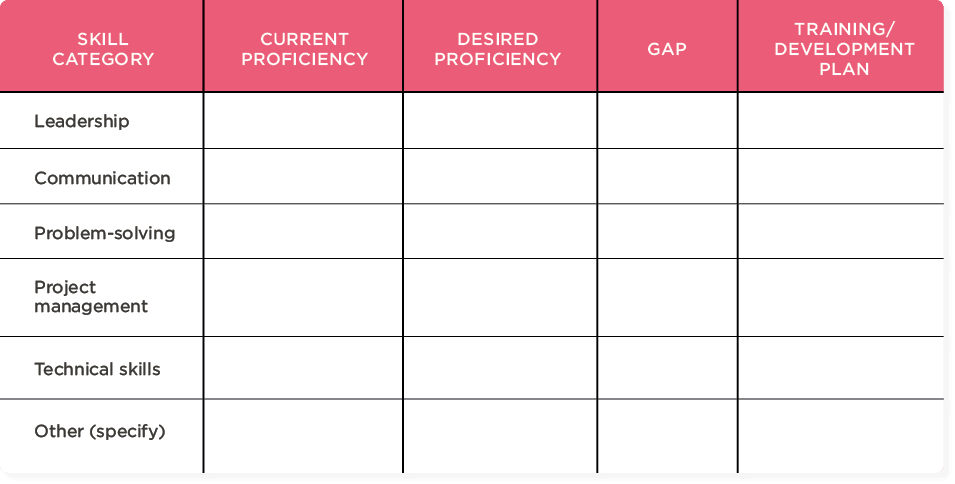
Employee development plan template
Now that you’ve spotted the skills gaps within the team, develop a plan to help your people achieve their full potential.
Employee development plans play a crucial role in cultivating a thriving and high-performing team. Personalized plans empower your people to concentrate on their career objectives, unlock their full capabilities, and amplify their value to the organization.
An employee development plan identifies and nurtures high-performing individuals within your organization who show the potential to step into critical leadership roles in the future.
It encompasses tailored training, mentoring, and experience opportunities that prepare individuals to assume executive positions when needed. This means you’re more likely to achieve a seamless leadership transition, sustaining your organization’s long-term success.
Succession planning template for strong candidate identification
To identify strong candidates, many teams use the 9-box model, or 9-box grid, to visually compare work performance and potential.
You can use the 9-box succession planning template to help you identify leaders effectively and strategically prepare people for future roles. Managers, especially those in charge of hiring up-and-coming talent, can also use it as a helpful succession planning template.
Using the information you’ve gathered from the other succession planning templates—like the skills gap analysis template and the employee development plan template—you can use this chart to place the right person in the right position at the right time.
From this chart, anyone in the “high performer, high potential” category is an ideal candidate to take on the role.
You may also include anyone within the “moderate performer, high potential” and “high performer, moderate potential” categories in your shortlist since these people could also be promising candidates.
<<Download and print these templates to build an effective succession plan.>>
Succession planning best practices
Succession planning lays the foundation for an organization’s enduring success. You can use these best practices when starting your succession planning:
Identify critical roles and competencies
Your organization relies on several core roles to run smoothly. What are they? What tasks can’t you skip for even a short amount of time without compromising the health of your business? Take a look at the most critical tasks in your organization and the skills required to complete those tasks. These roles take first priority as you develop your succession planning strategy.
Look beyond the current occupant and consider the evolving demands of the position. As the business grows and changes and teams shift in their focus and priorities, you may need to incorporate new skills and roles into your succession planning strategy.
Foster a culture of continuous learning and development
Prioritize ongoing learning and development to grow the current and future value of your people. Create a pool of potential successors by providing a clear path for growth, including training courses, skill development goals, and interactive performance tracking.
This also helps team members visualize their career pathing and take an active role in their skill growth.
Keep open lines of communication
Engage in candid conversations with your people about their career aspirations and potential growth within the organization. This demonstrates your commitment to their professional advancement and can help you identify high-potential individuals.
Recommended For Further Reading
Monitor and review your succession plan regularly
The business landscape is always evolving and so are the skills required for success. Regular updates and adjustments help ensure your plan remains agile, aligning with the company’s strategic goals and responding to emerging talent trends.
Put the “success” in succession with a succession planning template
Want to save the effort of creating your own templates from scratch? Easy: You can download ours.
(Or, if you want to be super efficient, you can look to some workforce planning software to do it for you.)
Remember, a successful succession plan is not just about filling positions—but about building a resilient and adaptive workforce that can weather any storm. Use our free succession planning templates to take the guesswork out of this strategic initiative and ensure smooth leadership transitions for sustained organizational growth.
<<Download this free succession planning template to stay ahead of your business needs.>>

